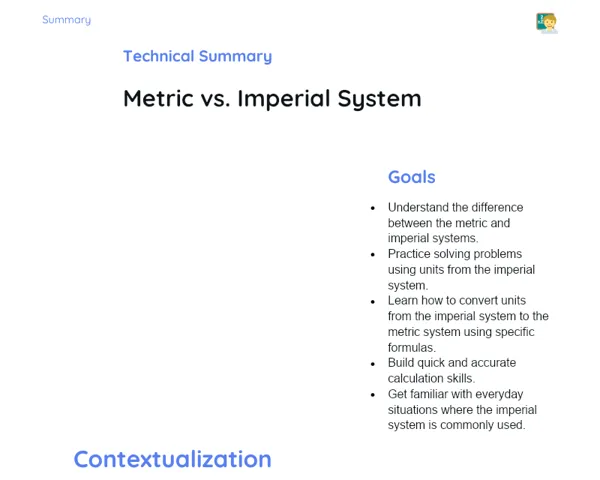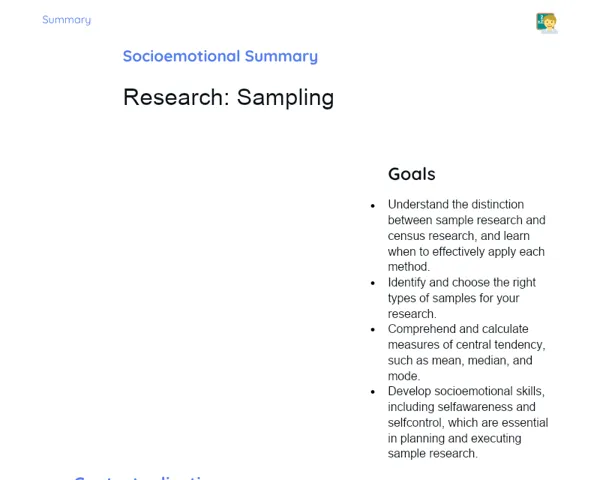Socioemotional Summary Conclusion
Goals
1. 🎯 Grasp and apply the conversion between units of length measurement (meter, kilometer, centimeter).
2. 💡 Tackle practical problems that involve converting units of length measurement.
Contextualization
🌍 Picture this: you’re gearing up for an exciting trip! To make the most of it, you need to figure out the distance between two cities or measure an item to ensure it fits in your suitcase. Being able to convert units of length empowers you to make accurate and well-informed decisions. Plus, honing these skills will enhance your problem-solving and logical thinking abilities. Ready to embark on this exciting journey together? 🚀
Exercising Your Knowledge
Units of Length Measurement
Understanding units of length measurement is vital for quantifying the size, height, or distance of objects and places. In the metric system, we mainly work with meters, kilometers, and centimeters. Getting a handle on these units is essential for navigating our daily lives and making accurate conversions in various situations.
-
🅼 Meter (m): The basic unit of length, perfect for measuring shorter distances in daily life, like the size of a room or a person's height.
-
🅺 Kilometer (km): Used for measuring long distances, such as the stretch between cities or the length of roads. 1 km equals 1000 meters.
-
🅲 Centimeter (cm): Ideal for measuring smaller objects and shorter distances. Remember, 1 meter equals 100 centimeters.
Conversion Between Units
Converting units of length is about transforming the measured quantity from one unit to another related unit. This skill proves to be quite handy in different practical scenarios and requires a solid understanding of the relationships among the units.
-
📏 Meters to Kilometers: To convert meters to kilometers, simply divide the number of meters by 1000. This simplifies the comprehension of large distances.
-
📐 Kilometers to Meters: For converting kilometers to meters, just multiply the number of kilometers by 1000. This is handy for precise measurements over long distances.
-
📏 Meters to Centimeters: To turn meters into centimeters, multiply the number of meters by 100. This is useful for accurately measuring small items.
-
📐 Centimeters to Meters: Converting centimeters back to meters involves dividing the number of centimeters by 100. This is crucial for grasping smaller measurements in the context of larger units.
Analogies of Conversion
Using analogies to grasp conversions can make learning more intuitive. Imagine each unit of measurement as part of a larger puzzle, where each piece plays a unique role and has a specific size.
-
🧩 Meter as the Core Unit: Envision the meter as the central piece of the puzzle, serving as the reference unit.
-
🚶♂️ Kilometer as a Long Journey: Think of a kilometer as a long stroll or a journey, indicative of its vast size.
-
🧩 Centimeter as a Tiny Piece: Relating the centimeter to a tiny puzzle piece helps convey its smaller scale.
Key Terms
-
🌐 Meter (m): The basic unit of length measurement in the metric system.
-
🌐 Kilometer (km): A larger unit of length measurement for lengthy distances.
-
🌐 Centimeter (cm): A smaller unit of length measurement used for short spans.
For Reflection
-
🤔 How did you feel working in pairs? Share your feelings and how you managed them.
-
🤔 What was the toughest challenge in the conversion activity and how did you tackle it?
-
🤔 How can you implement what you learned about unit conversion in your everyday life?
Important Conclusions
-
🔍 The ability to convert units of length like meters, kilometers, and centimeters is crucial for many practical scenarios. 🏠
-
🧠 Building this skill not only enhances your mathematical abilities but also aids in solving everyday issues more effectively. 💪
-
🤝 Teamwork and sharing solutions not only bolster your social and emotional skills but also offer a deeper understanding of the material. 🌟
Impacts on Society
Mastering measurement conversion greatly impacts our daily lives. For instance, knowing the distance between locations when planning a trip helps in calculating travel time and selecting the best route, making organization much simpler and saving time and resources. Additionally, this skill is key to everyday tasks like arranging furniture, following precise recipes, or engaging in sports that require accurate measurements. 📏✈️
On a broader scale, becoming proficient in measurement conversion can bolster your confidence in tackling practical challenges and applying mathematical concepts in real-life scenarios. The satisfaction that comes from solving intricate problems nourishes a sense of competence and self-esteem, crucial for personal development. 🌈💡
Dealing with Emotions
To handle your emotions while studying measurement conversion, try practicing the RULER method at home. First, Recognize your feelings when working on conversion problems - are you anxious, curious, or frustrated? Understand what’s causing those feelings - perhaps the complexity of the problem or lack of practice is affecting your mood. Label your emotions accurately, whether it's nervousness, excitement, or something else. Next, Express those feelings appropriately, either by discussing with a family member or jotting them down in a journal. Lastly, Regulate your emotions using techniques like deep breathing, taking study breaks, or listening to calming music. This way, you can be more emotionally prepared to continue your learning journey! 😊🧘♂️
Study Tips
-
📚 Create a Conversion Chart: Keep a handy chart with the main conversion formulas (meters to kilometers, kilometers to meters, and so on). This will aid in memorizing and better understanding the relationships between the units.
-
📝 Solve Practical Problems: Put the concepts learned into practice in real-life situations, like measuring the height of a tree or the distance between two points in your school.
-
👫 Study in Pairs or Groups: Collaborating with classmates can make learning more interactive and enjoyable. Trade problems to solve and discuss your solutions together!



